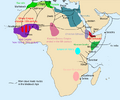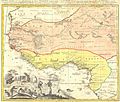African slave trade facts for kids
The African slave trade was a sad period in history. During this time, people from Africa were captured and sold as slaves around the world. This meant they were treated as property, forced to work without pay, and had no freedom.
The first major route for this trade went across the Sahara desert. This was known as the Trans-Saharan slave trade.
Later, after a time called the Age of Exploration (when Europeans explored many new parts of the world), the trade changed. African people were then taken across the Atlantic Ocean. This became known as the Atlantic slave trade. This type of slavery is what many people think of when they hear about slavery in modern history.
Even though slavery is against the law in most places today, it still happens in some parts of the world, including Africa. For example, in the country of Mauritania, slavery was only made illegal in August 2007.
Contents
What Was the African Slave Trade?
The African slave trade involved capturing people from different parts of Africa. These people were then sold and forced to work for others. This trade happened for many centuries. It caused huge suffering and loss of life.
Early Slave Routes
Before the Atlantic slave trade, there were other routes. One important route went across the Sahara Desert. This trade connected West Africa with North Africa and the Middle East. People were often taken from their homes and marched long distances.
Another route was along the East African coast. Here, people were traded across the Indian Ocean. They were sent to places like the Middle East, India, and even parts of Asia.
The Atlantic Slave Trade
The Atlantic slave trade began around the 1500s. It grew much larger than the earlier trades. European traders bought enslaved Africans and shipped them across the Atlantic Ocean. They were taken to the Americas and the Caribbean.
Why Did It Happen?
European colonies in the Americas needed many workers. They wanted to grow crops like sugar, tobacco, and cotton. They also needed people to work in mines. Enslaved Africans were forced to do this hard labor.
The Middle Passage
The journey across the Atlantic was terrible. It was called the "Middle Passage." Enslaved people were packed tightly onto ships. They had very little food or water. Many died from disease, hunger, or mistreatment during the journey.
Life as an Enslaved Person
Once they arrived, enslaved Africans were sold at markets. Their lives were extremely difficult. They were forced to work long hours. They had no rights and could be punished severely. Families were often separated and sold to different owners.
Ending the Slave Trade
Over time, more and more people realized that slavery was wrong. Groups began to fight for its end. This movement was called abolitionism.
Abolition Movements
In the late 1700s and 1800s, many countries started to ban the slave trade. Great Britain banned it in 1807. The United States followed in 1808. However, slavery itself continued in many places for decades longer.
Final Abolition
Slavery was finally abolished in the British Empire in 1833. In the United States, it ended after the Civil War in 1865. Brazil was one of the last countries in the Americas to abolish slavery, doing so in 1888.
Impact of the Slave Trade
The African slave trade had a huge and lasting impact. It deeply affected Africa, the Americas, and Europe.
Impact on Africa
The slave trade caused great harm to African societies. Millions of strong, young people were taken away. This led to a loss of population and slowed down development. It also caused wars and instability as groups fought over control of the trade.
Impact on the Americas
Enslaved Africans and their descendants built much of the wealth in the Americas. They brought their cultures, music, and traditions. However, they faced discrimination and hardship for centuries. The legacy of slavery still affects societies today.
Images for kids
-
A group of enslaved people in Zanzibar (1889)
-
Enslaved Malagasy people carrying Queen Ranavalona I of Madagascar
-
Nubians waiting to be sold at a slave market in ancient Egypt.
-
Release of Christian slaves by payment of ransom by Catholic monks in Algiers in 1661.
-
Black people captured in a slave raid being marched to a slave market in the Arab world.
-
A 'servant-slave' woman in Mogadishu (1882–1883)
-
Slaves in Ethiopia, 19th century.
-
A slave market in Khartoum, around 1876
-
Elderly female slave, around 1911-1915, owned by Njapundunke, mother of the Bamum king Ibrahim Njoya
-
Swahili-Arab slave traders and their captives along the Ruvuma River in Mozambique, 19th century
-
African slaves working in 17th-century Virginia, by an unknown artist, 1670
-
Slave trade along the Senegal River, kingdom of Cayor
-
Photograph of a slave boy in Zanzibar. 'An Arab master's punishment for a slight offence.' around 1890.
-
Cowrie shells were used as money in the slave trade
See also
 In Spanish: Esclavitud en África para niños
In Spanish: Esclavitud en África para niños

























